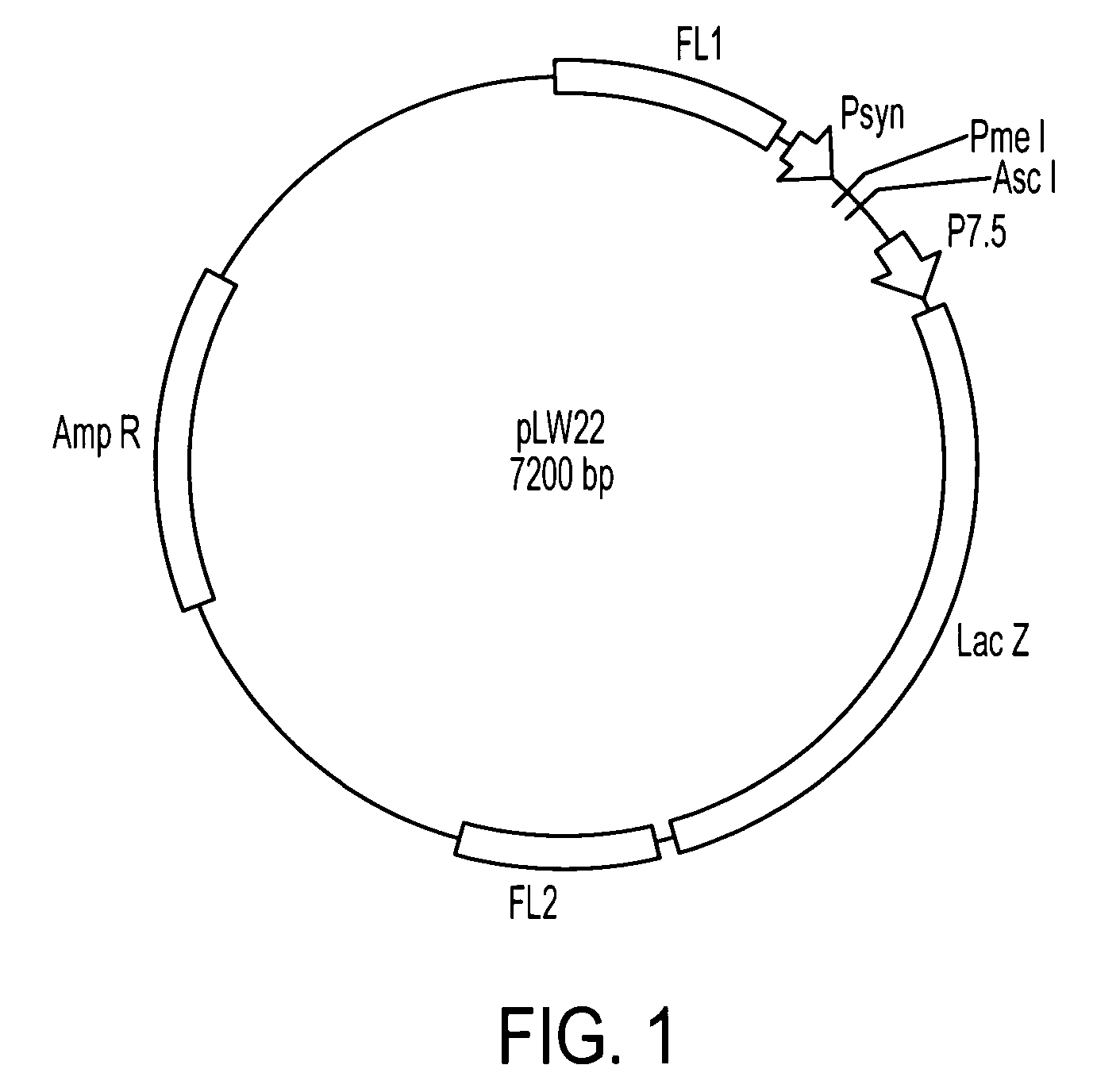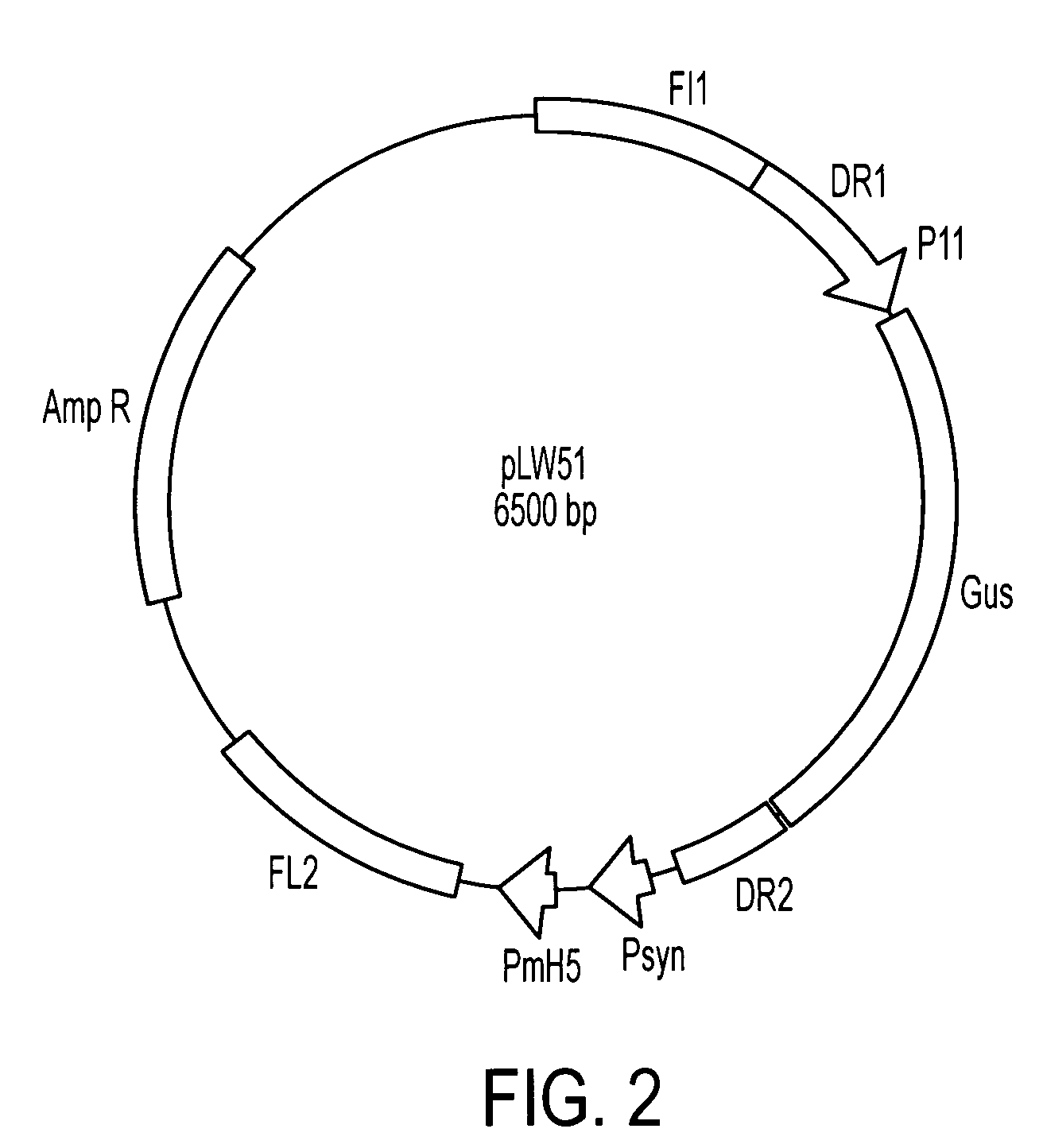Human cytomegalovirus antigens expressed in MVA and methods of use
a technology of human cytomegalovirus and antigen, applied in the field of human cytomegalovirus (cmv), can solve the problems of increasing the fatality rate of bacterial and fungal diseases, neutropenia, and the approach has several negative consequences in patients, so as to improve the immunity against hcmv
- Summary
- Abstract
- Description
- Claims
- Application Information
AI Technical Summary
Benefits of technology
Problems solved by technology
Method used
Image
Examples
example 1
Recombinant Vaccinia Virus Constructs
[0124]The human ubiquitin (Ub) gene was amplified using the following pair of primers: 5′-CAGTCAGCTAGCGTTTAAACATGCAGATCTTCGTGAAGACC-3′ (primer A; SEQ ID NO:8) and 5′-GGACAACGGCGACCGCGCGACTCCCTACCCCCCCTCAAGCGCAGGAC-3′ (primer B; SEQ ID NO:9). CMV (AD 169) pp65 gene was amplified using the following pair of primers: 5′-GTCCTGCGCTTGAGGGGGGGTAGGGAGTCGCGCGGTCGCCGTTGTCC-3′ (primer C; SEQ ID NO:10) and 5′-CCGGGTACCTCAACCTCGGTGCTTTTTGGGCGTC-3′ primer D; SEQ ID NO:11). Primers B and C were designed not only to complement each other, but also to contain the Arg codon (AGG), replacing Met (ATG) at the amino terminus of pp65. Alternatively, the primers can be designed to retain the ATG codon. The Ub gene (271 bp) and CMV pp65 gene PCR product (1680 bp) were fused together to generate the Ub-R-pp65 fusion gene by PCR using primers A and D. The PCR reaction conditions were five cycles at 94° C., 1 min; 55° C., 1 min; 72° C., 4 min followed by 20 cycles of 94° ...
example 2
IE1(4)-pLW22 Plasmid Construction
[0132]The IE1 cDNA was synthesized using mRNA isolated from CMV AD169-infected MRC-5 cells in a reverse transcription reaction using AMV reverse transcriptase (Promega, Madison, Wis.). The CMV IE1 gene, containing the entire IE1 ORF, was amplified using the forward primer 5′-GCAGTCACCGTCCTTGACACGATGGAG-3′ (SEQ ID NO:12) and reverse primer 5′-GTGACGTGGGATCCATAACAGTA-3′ (SEQ ID NO:13). The PCR product containing CMV IE1 (1.5 kb) was digested with SalI and BamHI and gel purified, then cloned into pBluescript SK(+)™ (Strategene, La Jolla, Calif.). From this plasmid, the IE1 exon 4 gene (IE1(4)) was generated by PCR amplification using the forward PCR primer 5′-AGCTTTGTTTAAACGCCACCACCATGGTCAAACAGATTAAGGTTCG-3′ (SEQ ID NO:14 and the reverse primer 5′-TTGGCCGCCTTTATTTGACGTGGGATCCATAACAGTAACTG-3′(SEQ ID NO:15). These primers contain PmeI and AscI restriction sites. After this PCR product was made, both the IE1(4) DNA and the pLW22 plasmid were cut with PmeI ...
example 3
pp65 / pp150-pLW51 Plasmid Construction
[0134]A pp150 gene for generating rMVA was generated by RT-PCR amplification from mRNA extracts of CMV-infected MRC-5 cells and cloned into the pBluescript cloning plasmid (Strategene, San Diego, USA). CMV pp150 cDNA was verified by restriction enzyme analyses and confirmed by DNA sequencing. For safety reasons, kinase-deficient pp65 is preferred for generation of rMVA for use in humans. A CMV kinase-deficient pp65 gene was developed which has a point mutation converting lysine to asparagine at amino acid position 436 to eliminate the threonine kinase activity. This mutant pp65, termed pp65(K436N), maintains immunogenic properties, as shown in pre-clinical animal studies.
[0135]CMV pp65 gene was PCR amplified using forward primer 5′-aaggaaaaaagcggccgcgccaccaccatggagtcgcgcggtcgccgttgtcc-3′(SEQ ID NO:20) and reverse primer 5′-aagaaggcctttatttcaccctcggtgctttttgggcgtc-3′(SEQ ID NO:21). The pp65 gene PCR product was gel purified and cloned into the Not...
PUM
 Login to View More
Login to View More Abstract
Description
Claims
Application Information
 Login to View More
Login to View More - R&D
- Intellectual Property
- Life Sciences
- Materials
- Tech Scout
- Unparalleled Data Quality
- Higher Quality Content
- 60% Fewer Hallucinations
Browse by: Latest US Patents, China's latest patents, Technical Efficacy Thesaurus, Application Domain, Technology Topic, Popular Technical Reports.
© 2025 PatSnap. All rights reserved.Legal|Privacy policy|Modern Slavery Act Transparency Statement|Sitemap|About US| Contact US: help@patsnap.com



